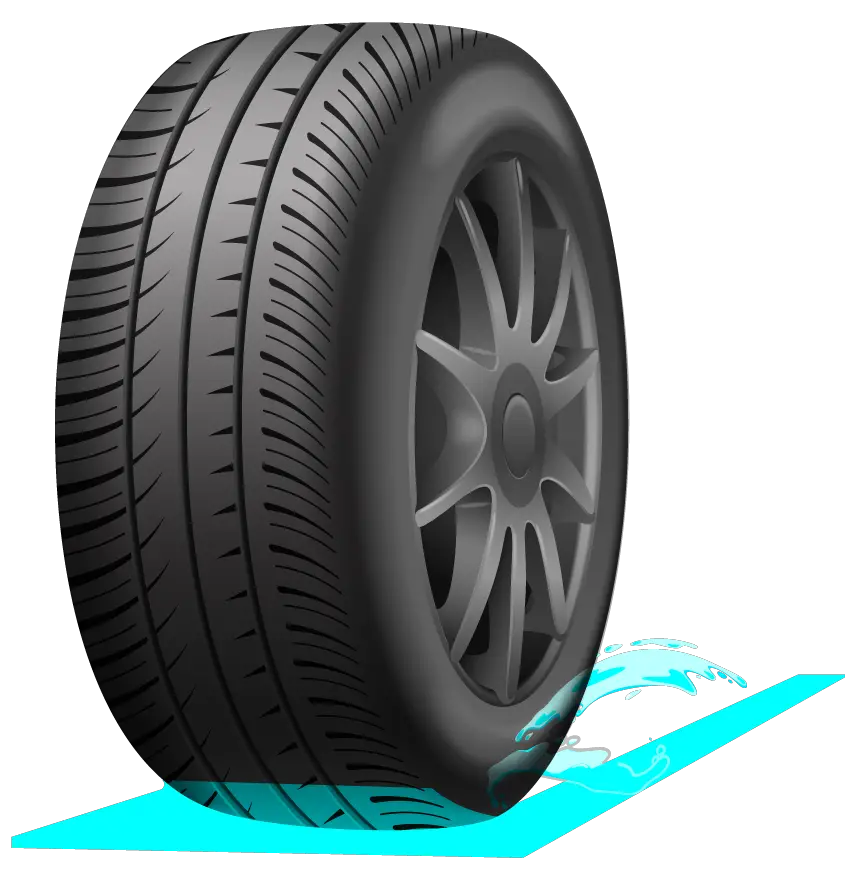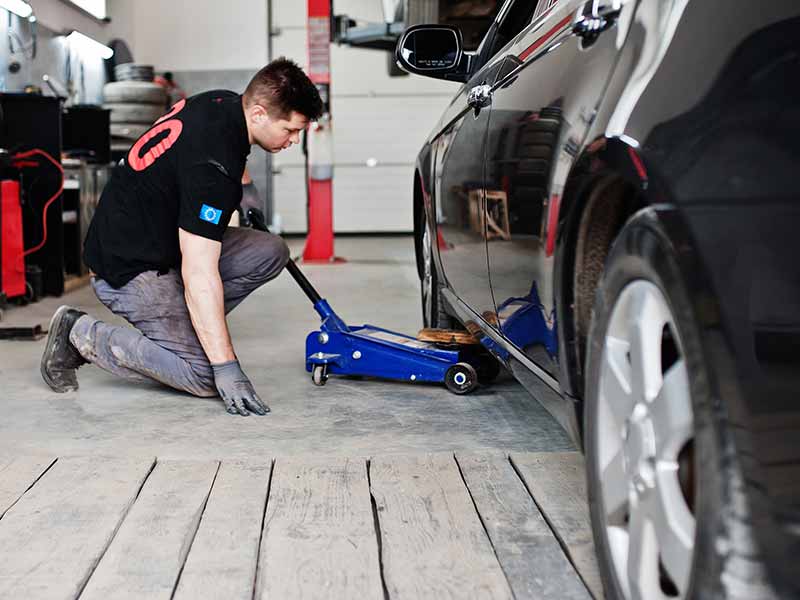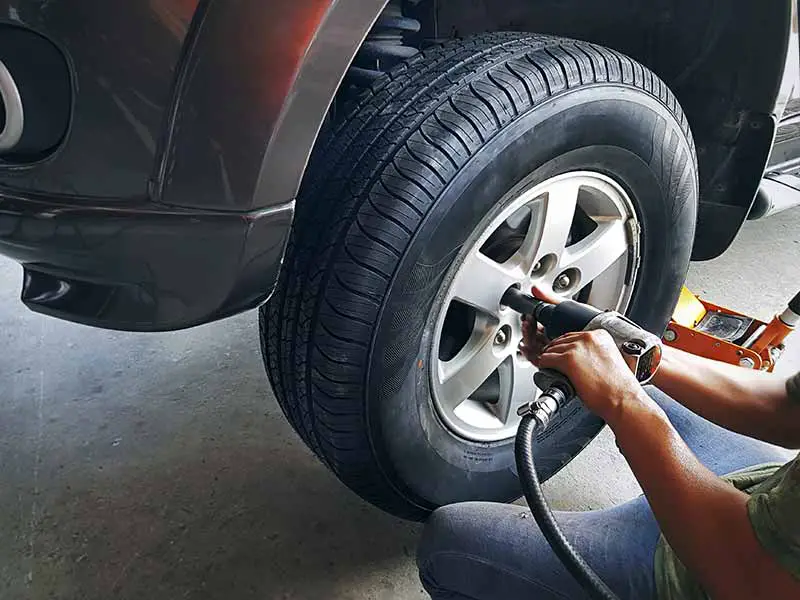Unfortunately, tires wear faster on either the front or rear axle usually and not evenly on both the front and rear tires. Front wheel drive cars and trucks tend to wear the front tires faster. Rear wheel drive vehicles tend to wear the rear tires faster.
Tire professionals, myself included, recommend replacing tires in pairs if not replacing all the tires. Many people will assume that the new pair of tires should be mounted on the front axle. After all, these tires are responsible for steering.
New Tires On The Front Or Back
When mounting a new pair of tires, the new tires should always be installed on the rear axle. This is because increased traction on the rear axle reduces the chance of oversteer, which is more difficult to recover from when losing traction.

A study showed that approximately 75% of consumers believe when purchasing just two tires, they should be placed on the front of the vehicle. Contrary to instinct, this is a very dangerous practice.
If front tires lose grip, they tend to go where they’re pointed and where the driver intends to steer them. But rear tires can lose grip in corners if they’re worn, especially in wet conditions. That’s why rear tires need to have the best traction possible to ensure their surface grip.
Let’s take a close look.
Why Do New Tires Go On The Rear?
Tires have an important role in wet weather conditions, providing traction for your car or truck. And they provide the most wet-weather traction and resistance to hydroplaning when they are new and have full tread depth. When we place the newer, better tires on the rear of the vehicle, we’re maximizing the traction and control available at the rear wheels, and therefore keep the rear of the car as planted and stable as possible.
For the average driver, a loss of control at the rear axle is very hard to manage. A loss of traction at the rear of the car often results in a spin and, possibly, an off-road adventure that could lead to an accident. On the other hand, a loss of control at the front axle doesn’t require the driver’s intervention as urgently, and it’s usually much easier to manage. The vehicle will tend to simply slide forward in a straight line.
Oversteer Vs Understeer
Oversteering and understeering are terms used to describe a loss of traction on the front or rear axles. A simple definition is understeering takes place when the car turns less than what the driver intended while oversteering happens when the car turns more than what the driver intended.
Both oversteer and understeer take place as a result of the difference in slip angle between the front and rear wheels. A slip angle is an angle difference between the direction of the car heading and the direction of the wheel heading.
In an understeer situation, the driver has often less control of the steering wheel, and the front wheels plow straight even if the steering is turned. In an oversteering situation, the car is too sensitive to the steering wheel and it starts to lose control in the backside, a phenomenon called fishtailing. In other words, if the car loses control of the front tires, it’s understeer, and if it loses control of the rear tires it’s oversteer.
In the case of oversteer, the driver’s ability to control the car is dramatically reduced. This is why oversteering is usually present in many single-vehicle loss-of-control accidents and rollovers. This is why tires that are new, and therefore have a better tread, should be always placed on the back of the vehicle.
Where Do New Tires Go On FWD, RWD, AWD, 4×4, & Trucks
The bottom line is that it doesn’t matter which axle is driving your vehicle forward. New tires should always go on the rear axle.
This again is advice that will sound incorrect to some that aren’t tire experts. Even seasoned car enthusiasts are caught off guard by this bit of information.
The reason that this fact is confusing is that drivers are thinking more about traction loss under acceleration or hard cornering on otherwise dry and grippy road surfaces.
This isn’t the scenario that most cars and trucks struggle to maintain traction or lead to the most accidents in wet weather conditions.
Loss of grip due to hydroplaning tires or wet roads can be affected by the axle or axles that are driven. But ultimately, if you lose traction on the back end of your car or truck it will be more difficult to control and recover.
If you can’t replace all four tires, move the partially worn tires to the front axle and the two tires you purchased on the rear.
Can I Put New Tires On The Front Anyway?
While you can obviously move your tires yourself once you get home, you will likely struggle to find any reputable tire shop you can talk into installing tires on the front axle of your car or truck.
We don’t recommend you swap the tires with the most tread depth to the front. Tire manufacturers have confirmed through testing that mounting worn tires on the front and the two tires that are new on the rear is the safest choice.
Aside from the fact that it has been proven that vehicles with better traction on the rear are more stable, there have been lawsuits that have found tire shops negligent due to having installed replacement tires on the front instead of the rear.

New Tires On Rear Lawsuit
When installing new tires, workers are trained to always install the new tires in the rear, no matter what the clients are suggesting. Not doing so can harm the client and therefore the company would be liable for damages.
One such example is from a lawsuit filed in May 2017, which alleges that the Walmart Tire & Lube Center acted negligently by installing two new tires on the front axle of a family vehicle. This allegedly led to a tread imbalance, which might have caused the car to spin out of control and crash into a tree. This accident in Massachusetts happened in the morning, on a day when the road was covered in ice. The driver of the car was pronounced dead at the scene, and the passenger was in a coma for weeks and will require a caretaker for the rest of his life.
This is just one example of lawsuits involving the negligence of companies that did not follow industry standards and installed new tires on the front axle, which resulted in accidents and even deaths.
Do All Four Tires Need To Be The Same Brand?
Another common question drivers have is if they can put different brand tires on a vehicle. While in theory, it might sound like a harmless practice, it should be avoided. Different brand tires can cause problems with traction control, stability, and more. The reason for these problems is the fact that no two brands produce tires with performance characteristics.
In some situations, it might be unavoidable to use different brands. When these cases occur, you should always purchase them and use them in pairs.
For example, don’t use one Goodyear, one Michelin, one Bridgestone, and one Continental. Instead, use them in pairs, such as two Goodyear and two Michelin. Try to match tires that are mounted to the same axle with the same brand, size, and tread wear level.
Two Different Size Tires On Front And Rear
Continental recommends fitting the same tires to every wheel position on your vehicle for optimal performance and safety. In this way, you’ll have the same brand, size, load index, tread pattern, and speed rating on the rear and front tires.
Driving with a set of tires that have a size difference can create issues with traction control system programming. The wheel speed sensors will not be able to properly interpret the speed of the individual wheels and this can lead to unpredictable behavior from the electronic stability control systems.
Some cars and trucks may come with different size tires mounted on the front and rear axles. It’s not uncommon for high-performance vehicles to have wider tires in the rear for improved traction. If this is your situation, you should continue to maintain the original equipment tire sizes.

It’s always recommended to follow the car manufacturer’s recommendations and consult a qualified tire specialist.
Resources
Below are some links you may find helpful when learning about tires.
Final Thoughts
No matter what type of vehicle or axle(s) of the vehicle drives it forward, when buying a new pair of tires, you should always mount them on the rear. This will ensure you get the maximum grip on the rear axle so you reduce run the risk of oversteering in heavy rain or standing water.
While most people will be surprised by this advice, the tire industry is more educated on this point than those who disagree.
Bottom line: If you buy just two tires, mount those tires on the rear.
Good luck and happy motoring.





